We recently published an Exit Readiness Playbook for our portfolio companies' leadership teams and board directors. One chapter focuses on Reputation Capital, which our Go-to-Market Center of Excellence generally finds to be an underserved area (of marketing, HR and customer success) of investment for startups and growth-stage companies. Our playbook explains how fostering an accurate and favorable public position is critical to and can create a halo effect for any sale or fundraising process. This is true. What's also true, however, is that it's a mistake to wait to give focus to such initiatives until you're contemplating a strategic process.
Building reputation capital lends credibility and reinforces differentiation in the market. It's simply good for business and will improve your company’s position and performance, especially when factoring your company's four key audiences: employees, customers, press and analysts.
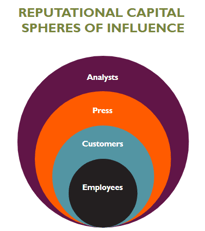
Following are five key levers for building reputation capital that can be executed with minimal effort and investment.
1. Employee Reviews
Your employees are a secret weapon and a key influence in your company’s attractiveness to a prospective employees, potential investors and acquirers. Culture is a new form of currency and ensuring that a positive and healthy work environment is reflected publicly is important. Begin by checking employee review sites (Glassdoor and Indeed primarily). and conduct a monthly audit to assess newly posted reviews. If reviews are negative, launch an initiative to further investigate and address the root cause.
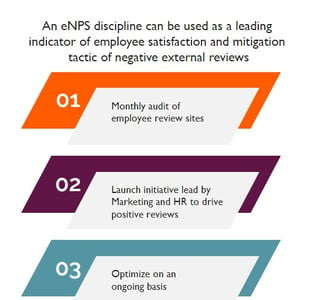 For starters, hand-select the up-and-comers from various teams and ask them to provide feedback on Glassdoor. This stacks the deck a bit and can accelerate what happens organically.
For starters, hand-select the up-and-comers from various teams and ask them to provide feedback on Glassdoor. This stacks the deck a bit and can accelerate what happens organically.
It's also only $500/month to maintain a branded Glassdoor program, which offers the opportunity to curate and telegraph the content and messaging you want to reach potential employees. Small dollars for big impact.
Further, instituting an internal Employee Net Promoter Score (eNPS) discipline can reveal how your employees feel about your company by measuring their willingness to recommend the workplace to family and friends.
Whether review sites or an eNPS system, it's important that HR commit to owning, monitoring, reporting on, and optimizing these programs on an ongoing basis. Marketing can be a great partner to HR in strategizing and executing these programs, too.
2. Customer Reviews
As potential employees, customers, investors and buyers conduct early diligence on your company, they will consult public sites to glean third-party information. Implementing an initiative to drive, monitor and manage these references will help elevate the perception of your company in the market, while ensuring it is framed in an accurate and favorable light.
A few examples worth highlighting across the Edison portfolio:
-
15Five gets high praise for its efforts in driving not only Glassdoor employee reviews, but also G2Crowd customer reviews (1700 strong!).
-
PathFactory also does a nice job driving G2 Crowd reviews and engaging customers based on their feedback.
-
MoneyLion has achieved >25,000 TrustPilot reviews with an Excellent rating.
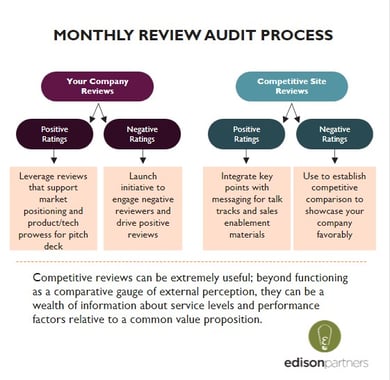
3. PR: Rolling Thunder
Many companies take a tactical firecracker approach to public relations, when a momentum-building rolling thunder approach is far more effective. Yieldstreet is a great example in the Edison portfolio, having put more than a dozen pieces of news on the wire over the last quarter. Again, this is simply good marketing practice, but if you are 12-18 months out from a potential sale or fundraising process, we highly recommend kicking off this sort of steady drumbeat of PR now.
A media relations agency can be retained to raise the profile of your company, communicating and amplifying signals of momentum in the business to garner coverage from relevant media outlets, speaking opportunities at relevant events, and award recognitions. News, customer/partner stories and other content assets (per the below graphic) can be leveraged and promoted through a variety of public-facing communication channels.
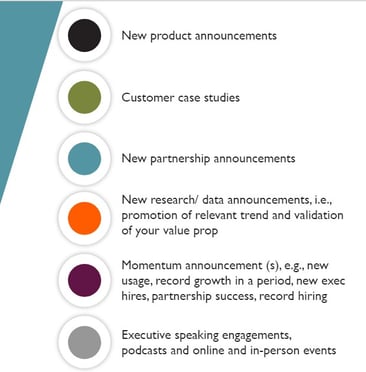
Keep your company’s social media presence fresh, optimizing the posting cadence and quality of thought leadership to drive engagement, industry presence and credibility with your audiences. This applies to company channels (LinkedIn, Facebook, Twitter, Instagram, TikTok), as well as executive team profiles and activity. Yieldstreet's Marketing team does a great job on this front, too, leveraging not only owned content, but also media coverage of timely and relevant topics as the basis of sharing a POV. Their LinkedIn feed is chock full of these sorts of posts.
4. IAR: Call The Authorities
Industry analysts covering your category are viewed as market authorities by your customers and potential investors and buyers. If the likes of Gartner, Forrester and others do not know your company or are not apprised on the latest developments in your business, now is the time to engage to establish or advance the relationship. In recent years, Edison portfolio company Terminus has achieved impressive results from their industry analyst relations efforts; they are the only vendor in their category to have been named a Leader in three notable analyst reports (Forrester ABM Wave, Forrester CDP Wave, and most recently, the Gartner ABM Magic Quadrant).
It’s a misconception that a subscription is required to engage the analyst community. Most will entertain briefing calls to obtain an update on your company, the solutions that you provide, and your differentiation against competitors in your category (it’s their job!). Potential customers, investors and buyers will also consult analyst reports and potentially ask analysts directly for their views on your company’s position and distinction in the market. It’s worthwhile to invest the time to secure and prepare for these briefings.
Also, be sure to check investor related sites (Crunchbase, Pitchbook, Prequin, CB Insights). Financial buyers spend lots of time here. If you are not a subscriber, contact their research teams who can provide your file for review and updates. You'll want to ensure your company’s profile is routinely updated.
5. From The Horse's Mouth
Nothing beats a third-party endorsement from the buyers and users of your product. And it's pretty much table stakes to have case studies and/or testimonials in some form on your website. Terminus produces a stable of high-quality, high-energy videos to tell their customer stories. Health Recovery Solutions is regularly telling their customer and user stories through case studies that quantify the value of their solution to healthcare providers, as well as feature patient (user) experiences. Recycle Track Systems, Northpass and PathFactory are also successfully capturing and promoting quantifiable results from their customers for their websites.
Keep your customer stories fresh, reflecting your value proposition in priority verticals or for key products, and diversifying formats so they content be readily tailored and promoted across channels, i.e., website, various social networks, events. An easy way to build your video testimonial inventory is to buy an inexpensive USB lavalier microphone, take it to events and conduct quick interviews in the corridor or on the show floor. You can also build a pipeline partnering with Sales to lock up opportunities while negotiating new contracts, i.e., provide discounts in exchange for testimonials and referenceability.
Further, while customer stories are important assets to showcase externally, your Net Promoter Score (NPS) is an important internal indicator of whether your customers would recommend you to others. If you do not have a NPS discipline in place, establish one. It should be led by Customer Success and the scores included as part of an executive dashboard so that management has visibility and degree of ownership to monitor and affect.

Prior to any fundraising or sale process, you'll want to ensure a NPS baseline exists, at minimum, as prospective investors and buyers will ask you for your current and historical performance, as well as future improvement goals.
You'll notice that these ways of building reputational value balance awareness-building for the business with community contribution for the greater good of your business' ecosystem. In the end, reputation capital is the sum of your intellectual property, the quality and safety of your product and service, and the trust and respect earned with your various audiences. It's a corporate asset to be managed and accumulated, and one that can have significant influence on how your business is valued in the market. Hopefully, the above five levers will inspire you to raise your reputation management game.

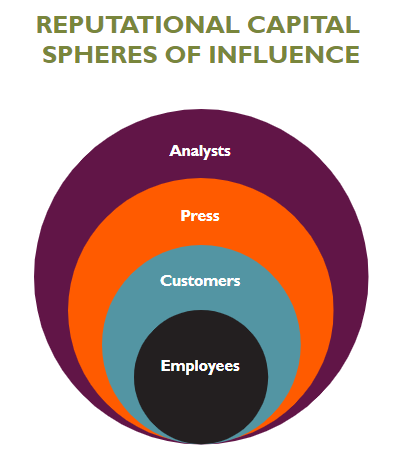
.png)